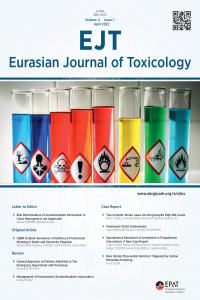İntihar Amaçlı İlaç Alan Hastalarda Kan Laktat Düzeyleri ile Klinik Sonuçlar Arasındaki İlişki: Retrospektif ve Tanımlayıcı Bir Çalışma
acil servis, laktat düzeyi, mortalite, intihar amaçlı ilaç alımı
The Relationship Between Blood Lactate Levels and Clinical Outcomes in Patients Taking Drugs for Suicide: A Retrospective and Descriptive Study
emergency department, lactate level, mortality, suicidal drug intake,
___
- 1. Senarathna L, Buckley NA, Jayamanna SF, Kelly PJ, Dibley MJ, Dawson AH. Validity of referral hospitals for the toxicovigilance of acute poisoning in Sri Lanka. Bull World Health Organ. 2012;90(6):436-443A. doi:10.2471/BLT.11.092114
- 2. Güloğlu C, Kara IH. Acute poisoning cases admitted to a university hospital emergency department in Diyarbakir, Turkey. Hum Exp Toxicol. 2005;24(2):49-54. doi:10.1191/0960327105ht499oa
- 3. B. Maharani and N. Vijayakumari., Profile of poisoning cases in a Tertiary care Hospital, Tamil Nadu, India. J App Pharm Sci. 2013; 3 (01): 091-094.
- 4. Akköse Ş, Köksal Ö, Fedakar R, Emircan Ş, Durmuş O. 1996- 2004 Yılları Arasındaki Erişkin Zehirlenme Olguları. Uludağ Üniversitesi Tıp Fakültesi Dergisi.2006; 32(1): 25-7
- 5. Zhang Y, Yu B, Wang N, Li T. Acute poisoning in Shenyang, China: a retrospective and descriptive study from 2012 to 2016. BMJ Open. 2018;8(8):e021881. Published 2018 Aug 29. doi:10.1136/bmjopen-2018-021881
- 6. Shah, Shreya M, Pratik D. Asari, and Anand J. Amin. "Clinico-Epidemiological profile of patients presenting with acute poisoning." International Journal of Current Research and Review 2016:8:35.
- 7. Datta D, Walker C, Gray AJ et al. Arterial lactate levels in an emergency department are associated with mortality: a prospective observational cohort study. Emerg Med J. 2015 Sep;32(9):673-7.
- 8. Dubose Jr TD. Acidosis and alkalosis. In: Longo, et al, editors. Harrison's principles of internal medicine. New York, NY: McGraw-Hill; 2012. p. 366.
- 9. Kraut JA, Madias NE. Lactic acidosis. N Engl J Med. 2014;371(24):2309-2319. doi:10.1056/NEJMra1309483
- 10. Pedersen M, Brandt VS, Holler JG, et al. Lactate level, aetiology and mortality of adult patients in an emergency department: a cohort study. Emerg Med J. 2015 Sep;32(9):678-84
- 11. Casserly B, Phillips GS, Schorr C, et al. Lactate measurements in sepsis-induced tissue hypoperfusion: results from the Surviving Sepsis Campaign database. Crit Care Med. 2015 Mar;43(3):567-73.
- 12. Kruse O, Grunnet N, Barfod C. Blood lactate as a predictor for in-hospital mortality in patients admitted acutely to hospital: a systematic review. Scand J Trauma Resusc Emerg Med 2011;19:74
- 13. Blum A, Zoubi AA, Kuria S, Blum N. High serum lactate level may predict death within 24 hours. Open Med (Wars). 2015;10(1):318-322. Published 2015 Jun 11. doi:10.1515/med-2015-0045
- 14. Bou Chebl R, El Khuri C, Shami A, et al. Serum lactate is an independent predictor of hospital mortality in critically ill patients in the emergency department: a retrospective study. Scand J Trauma Resusc Emerg Med. 2017;25(1):69. Published 2017 Jul 14. doi:10.1186/s13049-017-0415-8
- 15. Schollin-Borg M, Nordin P, Zetterström H, Johansson J. Blood Lactate Is a Useful Indicator for the Medical Emergency Team. Crit Care Res Pract. 2016;2016:5765202. doi:10.1155/2016/5765202
- 16. Jansen TC, van Bommel J, Schoonderbeek FJ, et al. Early lactate-guided therapy in intensive care unit patients: a multicenter, open-label, randomized controlled trial. Am J Respir Crit Care Med. 2010;182(6):752-761. doi:10.1164/rccm.200912-1918OC
- Yayın Aralığı: Yılda 3 Sayı
- Başlangıç: 2019
- Yayıncı: Acil Tıp Uzmanları Derneği
Deniz GEZER, Caner KAÇMAZ, Sencer YURTSEVER
Fampridin İntoksikasyonu: Olgu Sunumu
İlkay TÜRKÖZ, Melih Emre BACANAK, Pınar KARABACAK, Hacı Ömer OSMANLIOĞLU, Mustafa Soner ÖZCAN, Eyyüp Sabri ÖZDEN
Hüseyin ACAR, Mehmet Göktuğ EFGAN, Osman Sezer ÇINAROĞLU, Kadriye ACAR, Serkan BİLGİN, Ahmet KAYALI, Zeynep KARAKAYA
Psikiyatrik Tedavide Kullanılan İlaçların Neden Olduğu Nötropeni: Bir Olgu Sunumu
Liljana MEHMETAJ, Yasin UGUR, Bahadir TASLİDERE, Ertan SONMEZ, Basar CANDER
